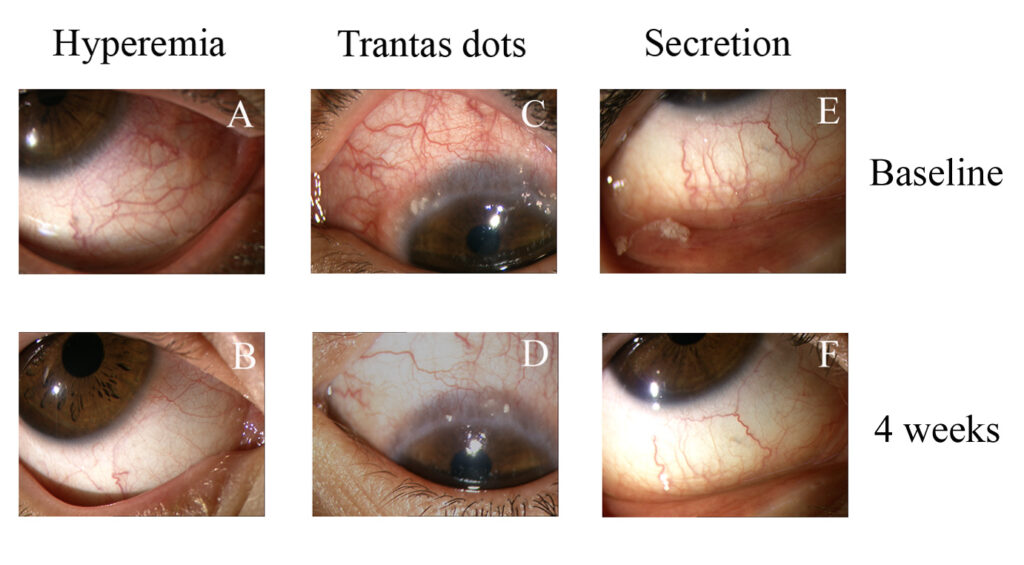Ophthalmology News
May 2009
by Vanessa Caceres
EyeWorld Contributing Editor
How oral or topical use of “friendly” bacteria may affect eye health
Probiotics are being hailed to help treat gastrointestinal tract problems, counteract the side effects of antibiotics, and offer general immune support. In fact, their benefits have turned them into a nutritional marketing tool as food manufacturers add them to products ranging from yogurt to cereal to granola bars.
Probiotics also may have an intriguing place in ophthalmology, particularly to help treat allergic conjunctivitis and inflammation from ocular rosacea or inflammatory dry eye.
“There’s possibly a very interesting role for probiotics in ophthalmology, either orally or topically,” said Robert Latkany, M.D., founder and director, Dry Eye Clinic, New York Eye and Ear Infirmary, New York. “Probiotics may represent a valuable and safe support to standard anti-allergic treatment in any form of allergic conjunctivitis, possibly decreasing on a long-term basis the use of topical steroids,” said Alfonso Iovieno, M.D., Interdisciplinary Center for Biomedical Research, Laboratory of Ophthalmology, University of Rome Campus Bio-Medico, Rome. Dr. Iovieno recently completed a study on probiotics used to treat vernal keratoconjunctivitis.
Here’s some background on how probiotics have infused positive bacteria into the medical field—and how they’re being tested in ophthalmology.

Source: Alfonso Iovieno, M.D.
A more natural treatment
“Probiotics are live microorganisms that are consumed because of their health effects,” said Mary Ellen Sanders, Ph.D., Dairy & Food Culture Technologies, Centennial, Colo. Dr. Sanders is a scientist who consults for a number of companies that sell probiotic products. Probiotic microorganisms include Bifidobacterirum animalis, Lactobacillus casei, Lactobacillus rhamnosus, Saccharomyces boulardii, and other species and strains. Probiotics are available as an oral supplement, or they can be placed in food—the public has learned more about probiotics as their health benefits have been publicized, Dr. Sanders said. Probiotics may be best known through the marketing of yogurt products such as DanActive and Activia, the latter of which uses the marketing name Bifidus regularis for the Bifidobacterium animalis strain it contains.
“For intestinal health, [the benefits] run the gamut from helping mild inflammatory bowel syndrome to helping with transit time [speeding up digestion]. They are also used for immune support to manage antibiotic-use symptoms and the duration of diarrhea,” Dr. Sanders said. Some general practitioners and gastroenterologists recommend that patients who take antibiotics also consume probiotics several hours later to counteract the negative effects of the antibiotics. There are also studies to indicate that probiotics can help people not get sick so often. “They’ve studied this in places like daycares in a controlled fashion and had mildly positive results,” Dr. Sanders said. Investigators are expanding probiotics’ possible uses by studying their use in treating Heliobacter pylori in the stomach, colitis, pouchitis, skin inflammation, and respiratory infection, she said.
Probiotics may have a future role in autoimmune diseases such as rheumatoid arthritis, Crohn’s disease, and lupus, said Barry R. Goldin, M.S., Ph.D., professor, Department of Public Health and Family Medicine, Tufts University School of Medicine, Boston, who has written about this topic.
“It’s interesting that people say, ‘If probiotics are good for the intestine, then maybe other colonized regions of the body might be affected,’” Dr. Sanders said. Probiotics are considered safe, although they can cause bloating and gas in some people. Plus, immunocompromised patients should generally avoid them. The most important safety and efficacy issue right now is discovering which strain of probiotic is best to treat specific conditions. “Not all probiotics are the same,” Dr. Sanders said. “There are different species and different strains of the same species. At this point, scientists consider the effects to be strain specific.”
Connection to ophthalmology
The connection between probiotics and the eye may seem far removed, but investigators are actually discovering a relationship. A study led by Dr. Iovieno and published last year in Graefes Archives of Clinical and Experimental Ophthalmology tested the use of a probiotic eye drop with Lactobacillus acidophilus for a month to treat seven patients with signs and symptoms of vernal keratoconjunctivitis. Investigators measured conjunctival hyperemia, chemosis, secretion, Trantas dots, and superficial punctuate keratitis, and their symptoms. They also performed impression cytology to evaluate the expression of ICAM-1 and TLR-4.
Investigators diluted Lactobacillus acidophilus into a saline solution to create the eye-drop solution.
Symptoms in all six patients who completed the study (one patient dropped out) were significantly improved at two weeks and four weeks. Clinical signs were also significantly better after four weeks (although not at the two-week mark). The impression cytology, which was performed in three patients, showed a down regulation of ICAM-1 and TLR-4 in two patients. “We were fairly surprised by the fact that every patient, regardless of statistically significant clinical improvement, described a positive effect of Lactobacilli eye drops on their symptoms, and none of them reported discomfort or the occurrence of side effects,” Dr. Iovieno said. He and fellow investigators are now analyzing the effects of prolonged oral consumption of Lactobacilli for more mild forms of eye allergies.
A number of allergy studies, some of which also track eye symptoms, are finding good results associated with probiotic use. A review article published in the December 2008 issue of Annals of Allergy, Asthma, and Immunology analyzed 12 randomized controlled trials that studied the effects of probiotics in allergic rhinitis and asthma. “Nine of the 12 randomized controlled trails that evaluated clinical outcomes in allergic rhinitis showed an improvement due to the use of probiotics,” wrote lead investigator Harissios Vliagoftis, M.D., Department of Medicine, University of Alberta, Edmonton, Alberta. “All the [trials] that studied perennial allergic rhinitis showed lower symptom scoring with the use of probiotics compared with placebo. Also, five of the eight [trials] that referred to seasonal allergic rhinitis suggested an improvement in clinical outcomes,” he wrote. Four of the trials reviewed also tracked ocular allergy symptoms; all four of those studies reported decreased eye symptoms after probiotic use. Although Dr. Vliagoftis and co-investigators wrote that the mechanism of action for probiotics in allergy is not entirely clear, they may have an effect on immune regulation by altering the composition of gut flora. Others have postulated a connection to the so-called “hygiene hypothesis,” which is based on research that finds children exposed to more microbes earlier in life actually have a lower incidence of allergy and asthma than children who are exposed to fewer microbes.
Nonetheless, the field is still confusing because there are so many probiotic strains with different effects on various diseases and conditions, Dr. Vliagoftis said. “It’s hard to generalize the results to everything,” he said. “Some studies show some effect, but how big the effect is, it’s difficult to know.”
The probiotics/allergy connection is further complicated by the question of when it is best to start probiotic use, Dr. Sanders said. For instance, the best time to administer probiotics may be to the mother when the baby is still in utero or when the baby is a newborn, she said. The use of probiotics for allergy in adults “may be too late,” she said.
Even though the research is still not definitive, Dr. Latkany is excited by the prospect of probiotics to treat underdiagnosed conditions such as ocular rosacea (which almost inevitably accompanies facial rosacea, where probiotics research has had good results) and inflammatory dry eye. “People are looking for an alternative to steroids,” said Dr. Latkany.
Future uses
In addition to honing in on the best strains to treat specific conditions, the Human Microbiome Project likely will affect probiotics research and consumption, Dr. Sanders said. Funded by the National Institutes of Health, the project is analyzing microbes found in the human body. These microbes are thought to interact with probiotics and contribute to probiotics’ effectiveness, Dr. Sanders said. “This research will have a big impact on probiotics,” she said.
Another future use may involve probiotics as an adjuvant for vaccines or to target the cause of a disease, Dr. Goldin said. For example, probiotics that modulate the immune system could target an infant milk allergy. “Medications from bacteria would be an interesting future compound,” he said.
Editors’ note
Drs. Latkany, Iovieno, Goldin, and Vliagoftis have no financial interests related to their comments. Dr. Sanders has financial interests with probiotic companies.
Contact information
Goldin: 617-636-3814, barry.goldin@tufts.edu
Iovieno: A.Iovieno@unicampus.it
Latkany: 212-689-2020, relief@dryeyedoctor.com
Sanders: 303-793-9974, mes@mesanders.com
Vliagoftis: 780-492-9295, harissios.vliagoftis@ualberta.ca



